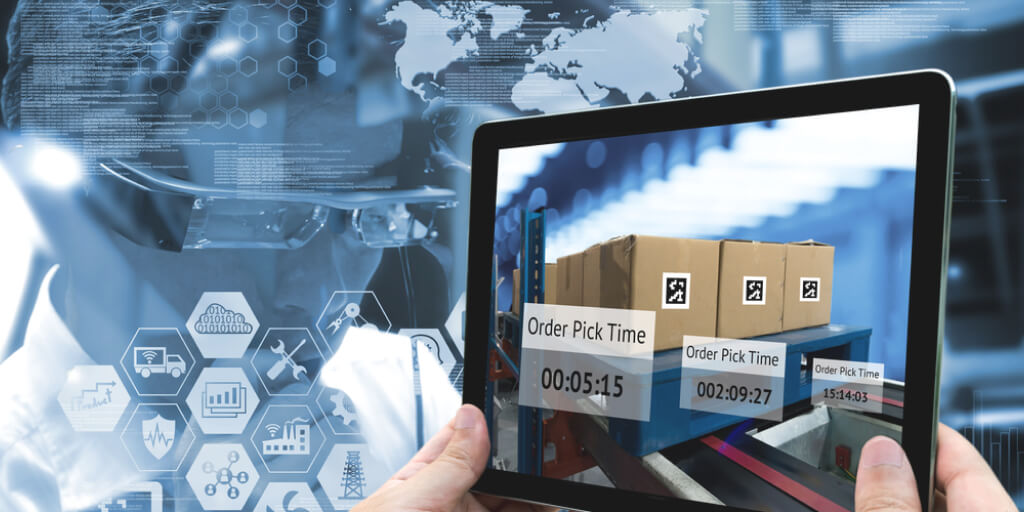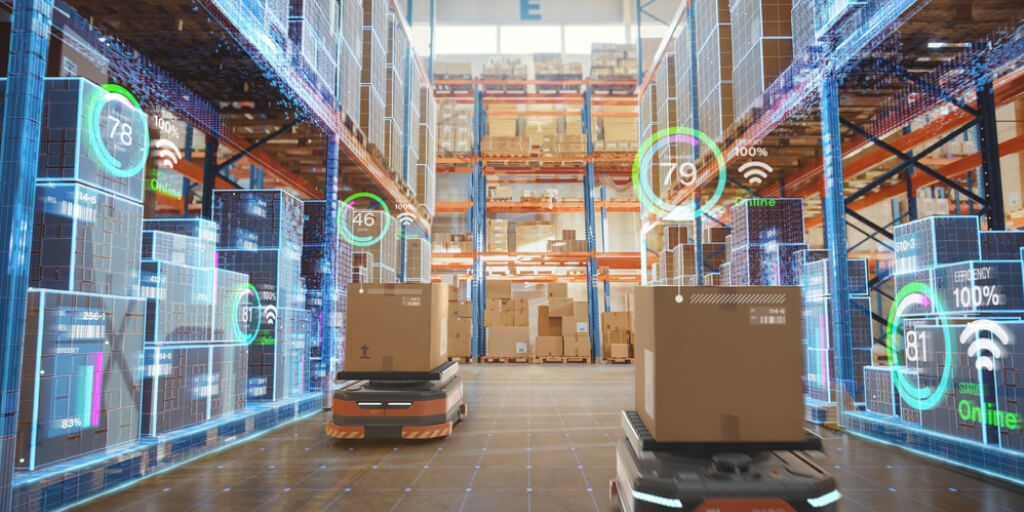Introduction
Rapid technological breakthroughs have recently altered the supply chain and logistics industries. Businesses are turning to cutting-edge technologies to optimize their operations due to the rising demand for the effective, affordable, and sustainable supply chain management.
Supply chain management and logistics technology services are undergoing a change thanks to new innovations like blockchain and predictive analytics. In this article, we’ll look at the top supply chain and logistics technology trends and their effects on business operations.
What is SCM (Supply Chain Management)

SCM is the management of the flow of goods and services and also includes the use of technology to track the raw materials and parts of products all the way through the supply chain. Imagine every ingredient that goes into a final food product all the way back to its origin in the field. This is achieved by using a combination of blockchain technology, IoT, AI, and big data analytics. We will explore each of these in more detail in the article. Overall SCM trends will help to identify the cost of product manufacture and transport in a much more granular way and also identify the sustainability of each product in terms of its overall carbon footprint from farm to fork.
Automation

In the logistics and supply chain sectors, automation is becoming more and more common, and for good reason. Businesses can automate many of their manual operations with the aid of cutting-edge technology like machine learning, artificial intelligence (AI), and robotics, which lowers the chance of errors, boosts efficiency and lowers costs.
The capacity to optimize workflows is one of automation’s key benefits in supply chain and logistics. Order fulfillment and lead times can be shortened by automating activities including inventory management, order processing, and delivery. Moreover, automated systems can run continuously, lowering the possibility of delays brought on by human error or outage.
Increased accuracy is another advantage of automation in the logistics and supply chain sectors. Automatic systems can track shipments in real-time and check inventory levels, giving firms the most recent data on their operations. This helps businesses make better decisions regarding their logistics and inventory plans, which eventually results in improved customer service and more profitability.
Automation is a major development in logistics and supply chain technologies that can help companies operate more effectively, accurately, and affordably. We may anticipate that more companies will implement automated technologies to enhance their supply chain and logistics operations as technology develops.
Blockchain

The supply chain and logistics sectors are quickly adopting blockchain technology. Blockchain is a decentralized, distributed ledger that facilitates safe, transparent, and tamper-proof transactions between participants without the use of middlemen. Because of this, it is the perfect solution for supply chain management, where accountability and openness are essential.
Improved traceability is one of blockchain’s main benefits in logistics and supply chains. Blockchain offers end-to-end tracking of products, from raw materials to completed goods, offering total visibility across the whole supply chain. This can assist in preventing counterfeiting, reducing fraud, and assure regulatory compliance.
Increased efficiency is another advantage of blockchain in the supply chain. With blockchain, supply chain participants can exchange data instantly, doing away with manual data entry and lowering the possibility of mistakes. This can speed up order fulfillment and lower costs by streamlining supply chain operations.
Moreover, blockchain technology can enhance supply chain sustainability. Blockchain can assist in locating inefficiencies and potential areas for development by offering comprehensive transparency into the whole supply chain. This may result in more environmentally friendly behaviors, such as cutting back on waste and carbon emissions.
Blockchain is a potential development in logistics and supply chain technology that can assist companies in achieving higher levels of sustainability, efficiency, and transparency. We may anticipate even more creative use cases in the supply chain and logistics sector as the technology develops and is embraced more widely.
Cloud logistics

Another development that is revolutionizing the supply chain and logistics sector is cloud logistics. Cloud logistics is the use of cloud-based technologies to manage logistical operations, such as transportation management, warehouse management, and inventory management.
Increased accessibility is one of the main advantages of cloud logistics. With cloud-based logistics solutions, organizations can access their logistical data from any location, at any time, and on any device with an internet connection. This can improve communication and collaboration among supply chain participants.
Increased scalability is another benefit of cloud logistics. Cloud-based logistics solutions are an excellent choice for companies with shifting supply chain requirements since they are simple to scale up or down to meet changing demand. In addition, cloud logistics solutions frequently offer reduced upfront costs and may be swiftly adopted, allowing organizations to begin experiencing the benefits of cloud-based logistics solutions in a quicker timeframe.
The supply chain can become more accurate and efficient with the use of cloud logistics. Real-time visibility into logistics processes, including inventory levels, order statuses, and transportation timetables, can be provided by cloud-based logistics solutions. This aids companies in making knowledgeable choices about their logistics plans, which eventually results in improved customer service and higher profitability.
Cloud logistics is a potential development in supply chain and logistics technology that can assist companies in enhancing their logistical operations’ accessibility, scalability, efficiency, and accuracy. We can anticipate even more creative use cases in the supply chain and logistics sectors as the technology develops and is embraced more widely.
Machine learning and artificial intelligence

The supply chain and logistics industries are being rapidly transformed by artificial intelligence (AI) and machine learning (ML). These technologies allow firms to automate and improve their logistical processes, which boosts productivity, accuracy, and cost-effectiveness.
Predictive analytics is one of the main advantages of AI and ML in the supply chain. AI and ML can assist in forecasting future demand and supply chain disruptions by examining historical data and current information. This can assist companies in making proactive adjustments to their logistics plans, lowering the possibility of stockouts, delays, and other problems.
Automation is another benefit of AI and ML in the supply chain. Several manual operations, like routing, scheduling, and inventory management, can be automated by organizations using AI and ML-powered solutions. This can help lower the possibility of mistakes, boost productivity, and eventually cut expenses.
AI and ML can also contribute to supply chain sustainability. AI and ML can assist companies in lowering their carbon footprint and promoting a more sustainable supply chain by optimizing logistics routes and minimizing transportation waste.
In general, AI and ML are important trends in supply chain and logistics technology that can assist companies in increasing the efficiency, accuracy, and sustainability of their logistics operations. We may anticipate even more creative use cases in the supply chain and logistics sectors as adoption increases.
Internet of Things (IoT)

Another trend that is changing the supply chain and logistics sectors is the Internet of Things (IoT). IoT refers to the usage of linked devices, sensors, and other things to gather and exchange data online. IoT can assist organizations in the supply chain and logistics space by enabling real-time asset, product, and shipment monitoring. This gives them more insight and control over their logistical processes.
Improved asset tracking is one of the main advantages of IoT in the supply chain. Businesses may monitor the location, temperature, humidity, and other conditions of their products and assets across the supply chain by employing IoT sensors and devices. In addition to enhancing product quality and safety, this can help reduce loss, damage, and theft.
Increased efficiency is another benefit of IoT in the supply chain. Businesses may enhance their logistics operations and cut costs by using IoT devices and sensors to give real-time data on inventory levels, production processes, and transportation routes. IoT can also assist organizations in automating a variety of manual procedures, including quality assurance and inventory management.
IoT can also aid in enhancing supply chain customer service. Businesses may keep their consumers informed and offer prompt updates in case of delays or problems by providing real-time data on shipment status and location.
IoT is a promising development in logistics and supply chain technology that has the potential to improve customer satisfaction, visibility, and efficiency in business operations. We can anticipate even more creative use cases in the supply chain and logistics sector as the technology develops.
Autonomous vehicles

Autonomous vehicles, commonly referred to as “self-driving cars,” are a growingly common development in logistics and supply chain technology. The ability of these cars to travel roads and highways without the assistance of a human being depends on a combination of sensors, cameras, and mapping technologies.
Improved efficiency is one of the main advantages of self-driving cars and trucks. Self-driving vehicles can work around the clock since they don’t require a human driver, which speeds up deliveries and lowers the expense of paying drivers’ salaries and benefits.
Self-driving cars can potentially contribute to increased road safety and have the potential to reduce accidents and increase overall road safety by eliminating human error, such as distracted or tired driving.
Autonomous vehicles can also assist companies in lessening their environmental impact. They can help reduce emissions and enhance air quality by optimizing routes and cutting down on pointless idling and accelerating.
However, there are still obstacles with self-driving cars that need to be resolved, such as regulatory and legal issues, cybersecurity worries, and public perception and acceptability issues. Notwithstanding these difficulties, supply chain and logistics technology’s optimistic trend toward autonomous vehicles has the potential to completely transform the sector in the years to come.
Transportation Management Systems (TMS)

Transportation Management Systems (TMS) are software programs that assist companies in streamlining all aspects of their freight operations, from planning and execution to payment and auditing. TMS solutions can save transportation costs, increase productivity, and provide visibility into a company’s logistics operations.
Increased visibility into transportation operations is one of TMS‘ main advantages. Businesses can manage shipments, keep an eye on carrier performance, and find inefficiencies in their transportation processes with the use of real-time data and analytics. In order to optimize their logistics operations and cut expenses, firms can use this to make data-driven decisions.
Improved efficiency is another benefit of TMS. The time and effort needed to manage transportation operations can be decreased by using TMS solutions to automate several manual activities, including carrier selection, load planning, and appointment scheduling. TMS solutions can also assist companies in streamlining their modes of transportation, lowering lead times and cost-per-mile.
TMS can also aid in enhancing customer service throughout the supply chain. Businesses can proactively communicate with customers about shipment status and delivery times using real-time data and analytics, increasing customer happiness and loyalty.
TMS is a major development in logistics and supply chain technology that can help companies improve their transportation operations’ efficiency, visibility, and customer service. We may anticipate even more creative use cases in the supply chain and logistics sector as the technology develops.
eCommerce logistics

The supply chain sector is experiencing a fast-expanding trend in eCommerce logistics. Businesses are putting more effort into improving their eCommerce logistics operations as online shopping becomes more popular in order to meet customer expectations for prompt and dependable delivery.
The requirement for quick and flexible fulfillment is one of the main issues in eCommerce logistics. Orders must be processed and shipped quickly by eCommerce businesses, frequently with same-day or next-day delivery. Businesses are utilizing cutting-edge logistics technology like robotics and automation to increase fulfillment speed and accuracy in order to meet these expectations.
The requirement for effective and affordable last-mile delivery is another difficulty in eCommerce logistics. The last mile of the delivery process, from the distribution center to the customer’s door, is referred to as “last-mile delivery.” Businesses are addressing this issue by utilizing cutting-edge delivery models, such as crowdsourcing and delivery networks, to improve last-mile delivery and lower transportation costs.
Strong inventory control and visibility are also necessary for eCommerce logistics. Businesses need to be able to check inventory levels and shipments in real-time and make data-driven decisions to optimize their logistics operations due to the enormous number of SKUs and the high volume of orders.
Overall, eCommerce logistics is a major development in supply chain and logistics technology that can assist companies in meeting the requirements of the contemporary eCommerce market. Businesses may increase the efficiency, speed, and customer satisfaction of their eCommerce logistics operations by utilizing cutting-edge logistics technologies and delivery models.
Analytics and big data

“Big Data Analytics” is a significant development in logistics and supply chain technologies. Businesses can utilize “big data analytics” to obtain insights into their logistics operations, streamline processes, and enhance decision-making thanks to the growing availability of data from a variety of sources.
Improved visibility into logistics operations is one of the main advantages of “big data analytics.” Businesses can get real-time insights about the location and status of shipments, as well as transportation performance and efficiency, by evaluating data from sources like GPS, sensors, and telematics. This can assist companies in making data-driven decisions to streamline logistical processes and cut expenses.
Seeing patterns and trends in logistics data is another benefit of big data analytics. Businesses can find inefficiencies in their logistics operations and make modifications to maximize performance by examining historical data. For instance, big data analytics can assist firms in determining the most effective shipping routes, optimizing warehouse layouts, and enhancing inventory management.
Supply chain risk management can be enhanced with the aid of big data analytics. Businesses can spot possible disruptions to their logistics operations and take proactive steps to reduce risks by examining data from a variety of sources. For instance, big data analytics can assist companies in identifying weather patterns that may affect shipping routes and proactively rerouting shipments to prevent delays.
Big Data analytics is a major development in logistics and supply chain technology that has the potential to improve business operations in terms of visibility, efficiency, and risk management. We anticipate even more creative use cases in the supply chain and logistics sectors as the technology is embraced more widely.
Warehouse automation
In the supply chain sector, warehouse automation is a trend that is quickly expanding. Businesses are turning to cutting-edge automation solutions to streamline their warehouse operations and increase productivity in response to the growing need for quick and reliable delivery.
Increased efficiency is one of the main advantages of warehouse automation. With the help of automation technologies like robotics, automated storage and retrieval systems, and conveyor systems, organizations can automate many manual warehouse procedures, saving time and effort. This can help firms increase throughput and lower personnel costs.
Improved accuracy is another benefit of warehouse automation. Automated warehouse technology can help eliminate mistakes made during order picking, packing, and inventory management, increasing order accuracy and lowering the possibility of receiving complaints from customers.
Automation in the warehouse can also help increase security, and businesses can improve employee safety and save on workers’ compensation costs by using automated material handling systems to reduce the chance of accidents and injuries.
Overall, warehouse automation is a big step forward in logistics and supply chain technology. It can help companies make their warehouse operations more accurate, precise, and safe.
Supply chain SaaS

A developing trend in supply chain and logistics technology is software-as-a-service (SaaS). Businesses are turning to SaaS vendors to manage their supply chain and logistics operations due to the rising demand for cloud-based software solutions.
More flexibility is one of SaaS’ main advantages in the supply chain. Businesses can use supply chain and logistics software via cloud-based SaaS solutions from any location with an internet connection, making it simple to manage operations across several sites or even internationally. This can help firms optimize their supply chain and logistics operations and decrease the requirement for expensive on-premises software deployments.
Reduced IT expenditures are another benefit of SaaS in the supply chain. SaaS solutions allow organizations to access software on a cloud-based platform for a monthly fee rather than investing in costly hardware and software installations. Businesses can quickly add or delete users as needed without the need for extra hardware or software, which can lower IT expenses and enhance scalability.
SaaS solutions can also aid in enhancing supply chain collaboration and communication. Businesses may effortlessly share data and work in real-time collaboration with partners, suppliers, and customers using cloud-based SaaS systems. This can enhance supply chain visibility and lower the possibility of mistakes during logistical operations.
SaaS is a significant development in logistics and supply chain technology that can assist companies in achieving better flexibility, scalability, and collaboration in their logistics operations. We expect even more creative use cases in the supply chain and logistics sector as the technology develops.
Reverse logistics

Reverse logistics is the process of controlling the movement of products from the point of consumption back to the point of origin. This can apply to product recycling, returns, fixes, sales, and replacements. As companies look to increase sustainability and cut waste in their operations, reverse logistics is becoming a more crucial component of supply chain and logistics operations.
Improved sustainability is one of the main advantages of reverse logistics. Businesses can reduce waste and have a better impact on the environment by controlling the flow of goods back through the supply chain. This can involve reusing or recycling materials, selling still-usable things, or fixing products to increase their useful lives.
Improved client satisfaction is another benefit of reverse logistics. Businesses can increase customer loyalty and retention by providing simple return and exchange policies. Increased sales and revenue may result from this, which can also help to improve brand reputation.
Businesses can cut costs by using reverse logistics. Businesses can cut down on the requirement for new product manufacture and save money on raw materials and production costs by reselling or repairing products. This can increase profitability and lessen the negative effects of production on the environment.
Reverse logistics is a major development in supply chain and logistics technology that has the potential to improve sustainability, customer happiness, and cost savings for enterprises.
3D printing

Making tangible products out of digital models is a method known as 3D printing, commonly referred to as additive manufacturing. As companies look to increase productivity and cut costs in their production processes, 3D printing is becoming more common in supply chain and logistics operations.
Improved flexibility is one of the main advantages of 3D printing in the supply chain. With 3D printing, firms can rapidly and efficiently produce customized goods and parts on demand, eliminating the need for pricey inventory management and hoarding. This can help firms increase the agility of their supply chains and react to shifting client demands more rapidly.
Reduced expenses are another benefit of 3D printing. Businesses can eliminate the requirement for pricey tooling and setup expenses associated with conventional manufacturing processes by producing goods and parts as needed. This can increase profitability and lessen the negative effects of production on the environment.
Moreover, 3D printing can reduce lead times and enhance product quality for enterprises. Businesses can shorten the time it takes to make things and raise the overall quality of their goods by doing away with the need for intricate manufacturing procedures and supply chain operations.
Overall, 3D printing is a major trend in supply chain and logistics technology that can assist companies in increasing their manufacturing operations’ flexibility, cutting costs, and producing goods of higher quality.
Sustainability
Sustainability is an increasing concern for organizations in many sectors, and the supply chain and logistics sector is no different. Businesses are increasingly attempting to integrate sustainability into their supply chain and logistics operations as a result of increased pressure from consumers, investors, and authorities to decrease environmental impact and promote social responsibility.
Technology is one way that companies are enhancing the sustainability of their supply networks. Many of the developments we’ve covered, including blockchain, cloud logistics, and reverse logistics, can assist companies in cutting waste and increasing efficiency, resulting in a more sustainable supply chain.
Businesses are also increasingly embracing sustainable materials and production techniques in their supply chains. This involves the utilization of recycled materials, renewable energy sources, and environmentally friendly manufacturing techniques. Businesses can lessen their impact and increase their social responsibility by integrating these sustainable practices into their supply chains.
Sustainability is important for meeting the needs of investors, consumers, and regulators, but it can also save a lot of money. Businesses can lower their operational expenses and boost profitability by cutting waste and increasing efficiency. Businesses that place a high priority on sustainability can also enhance their brand reputation and draw in customers who are becoming more conscious of the environmental effects of the things they buy.
Overall, sustainability is a major trend in logistics and supply chain technology that is propelling innovation and transformation in the sector.
Conclusion
In conclusion, supply chain and logistics technologies are continuously developing, with new trends and innovations appearing constantly. Businesses are utilizing technology to increase productivity, cut costs, and boost customer satisfaction, from automation and blockchain to 3D printing and sustainability.
Businesses must use these technologies not only to be competitive, but also to satisfy customer needs for quick, dependable, and sustainable supply chain operations. Businesses that prioritize sustainability in their supply chain and logistics operations will have a competitive edge given the mounting push to decrease environmental impact and promote social responsibility.
Businesses need to be flexible and adaptive to take advantage of new technology and stay ahead of the competition as the supply chain and logistics sector continues to change. They can enhance their supply chain and logistics operations, lower costs, and increase customer satisfaction by keeping up with the most recent trends and developments.
How we can help
At Blue Whale Apps, we offer a full range of consultation, research, design, and build services for supply chain management, SCM trends, and logistics technology solutions. For more information and a free consultation, please complete the contact form, and one of our experts will be in touch.






